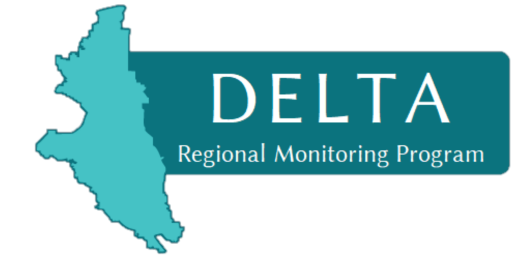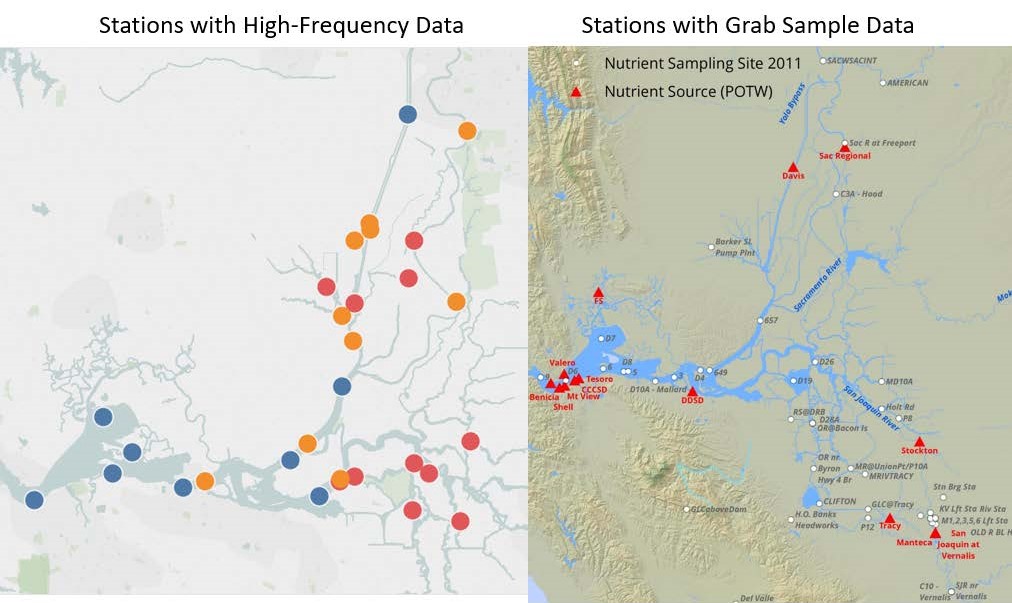the Delta Regional Monitoring Program
Water Quality Monitoring and Studies
Regional monitoring informs management and policy decisions facing the Delta.
The Delta RMP has prioritized the following monitoring sectors for funding data collection and analysis. Explore each tab for more information on the monitoring strategies and published reports.
Monitoring Plan
In 2018-19, the Delta RMP developed a Quality Assurance Program Plan (QAPP) and plan for program implementation of the CEC Pilot Study. Program implementation included optimization of the pilot study work plan, logistics planning, sample collection and analysis vendor selection process administration, contract set-up with vendors, coordination with other monitoring programs, facilitation of the Technical Advisory Committee CEC Subcommittee, and start-up mobilization for 2019-2020 sample collection. Year 1 of this project received funding as a part of a Central Valley Water Board enforcement action.
Monitoring Plan
A multi-year study of current-use pesticides and aquatic toxicity in the Sacramento-San Joaquin Delta began in 2018 (Year 1). A rotating basin monitoring design with monitoring at two fixed sites began in October 2018 and is designed to be a 4-year monitoring program covering six Delta sub-regions. At the end of the monitoring, an interpretive report will inform adaptive management and improve future monitoring. Annual data reports describing the monitoring conducted for the previous water year and associated quality assurance assessment of the data are reviewed by the Delta RMP annually.
Reports
- 2015-2016 Pesticides & Toxicity Monitoring Report
- 2018-2019 Pesticides & Toxicity Monitoring Report*
- 2019-2020 Pesticides & Toxicity Monitoring Report*
- WY 2021 Data Report and Quality Assurance Evaluation
- WY 2023 Data Report and Quality Assurance Evaluation with Appendices
- WY 2024 Data Report and Quality Assurance Evaluation with Appendices
*AHPL’s 2018-2020 midge survival data do not follow the current SWAMP business rule when there are missing organisms or pupae.
- Analysis and Interpretation of Pesticides and Toxicity Monitoring Data in the Sacramento-San Joaquin Delta
Monitoring Plan
The information collected as part of the Delta Regional Monitoring Program (DRMP) mercury monitoring sector is critical to implementing the Delta MeHg Total Maximum Daily Load (TMDL), providing calibration and validation data for a Department of Water Resources (DWR) mercury model, and informing other management and regulatory decisions related to water quality improvement and ecosystem restoration in the Delta. This monitoring has provided essential evidence for regulators implementing the TMDL and contributes to ongoing analytical work by DWR. The DWR model was used to guide regulations and operational decisions related to farming, flood control, and wetland management. Central Valley Water Quality Control Board (CVRWQCB) staff used these data to inform the 2020 Delta Mercury Control Program including Phase 2 potential modifications and options.
Annual sport fish sampling was last conducted in September 2022. The indicator of primary interest was total mercury in muscle fillet of 350-mm largemouth bass (or similar predator species). Total mercury is a close surrogate for the element’s more toxic form, methylmercury (MeHg). The locations of the trend sites for black bass collection represented different subareas of the Delta and were co-located with the water monitoring sites. Water sampling was conducted in conjunction with sport fish monitoring. Indicators of primary interest were concentrations of methylmercury and total mercury in water. Important ancillary parameters included chlorophyll-a, dissolved organic carbon (DOC), suspended sediment concentrations, total suspended solids (TSS), and volatile suspended solids (VSS).
Beginning FY 22-23, mercury monitoring rotated into a long-term planning stage. As part of the long-term planning process, an interpretive report was developed with a primary audience of the CVRWQCB and Methylmercury TMDL stakeholders and an objective to assess trends in fish tissue and aqueous methylmercury concentrations and evaluate other factors impacting trends in methylmercury concentrations. Data utilized in the Mercury Interpretive Report and accompanying Factsheet included data generated from 2016 – 2022 and the report evaluated trends in aqueous and fish tissue mercury concentrations since 2000 in the context of water year type and subarea.
Reports
MONITORING PLAN
Nutrient Multi-Year Study Plan
The Delta Regional Monitoring Program (DRMP) developed a Nutrient Multi-Year Study Plan to guide long-term studies of the effects of nutrients on the ecology of the Delta. Three primary questions (also referred to as focus areas) were developed to guide the development of the Study Plan. The DRMP Nutrient Multi-Year Study Plan was approved in March 2024 and includes efforts in the following areas:
Focus Area #1 – Biogeochemical modeling will be performed utilizing a series of model scenarios to assess the following question: Following a reduction in nutrient loading from point and nonpoint sources, what ranges of nutrient concentrations are expected to occur throughout the Delta, and how might they be affected by water year (flow), climate change, wetland restorations, and water management and routing?
Focus Area #2 – To assist with understanding the ecological effects of nutrient reductions, a bioassay study will be used to answer the following question: What are the thresholds for nutrients (N and P and their ratios) that can limit harmful algal blooms (HAB) biomass and cyanotoxin accumulation to safe levels, limit the abundance and distribution of nuisance macrophytes, and support robust growth of desirable phytoplankton and macrophytes throughout the Delta?
Focus Area #3 – The DRMP will look for opportunities to collaborate or leverage funding to address the question: How are characteristics of harmful cyanobacteria blooms in the Delta changing over time, including the status of cyanobacteria blooms and cyanotoxins in the Delta and factors that affect their magnitude, geographic extent, and timing?
The Nutrient Multi-Year Study Plan addresses these three questions or focus areas using a combination of modeling, field/experimental studies, and monitoring. It is not the objective of this Nutrient Multi-Year Study Plan to completely address all three focus area questions. The intent of the studies included in this Study Plan is to begin a multi-year process that begins to address these questions with a hypothesis driven approach and prioritizes data gaps identified by the Steering Committee and Nutrient Technical Advisory Committee.
COMING SOON
The DRMP is in the process of developing the steps for submitting a proposal that meets the objectives of HAB Collaborative Monitoring (Focus Area #3). In the meantime, please reach out to the DRMP Program Manager with any questions.
Biogeochemical Model – WY2011 and WY2016
Inset: Stations with data that were used for the modeling analysis.
Data Synthesis and Modeling
This study focused on recent work updating the northern San Francisco Estuary Biogeochemical Model (nSFE-BGCMv2), including calibration and model simulation across two water years (WY) that differed in both their physical forcings (dry vs. wet) and biogeochemical responses (WY2016, WY2011). The study design leveraged in-kind modeling resources from the Department of Water Resources while taking advantage of information gleaned from studies funded by other parties. This project implemented a recommendation to increase data sharing among different models and monitoring programs. For this study, a hydrodynamic-biogeochemical model of the Delta in WY2016 was combined with water quality measurements to better understand what caused large phytoplankton blooms in WY2016. This effort involved the application and calibration of a biogeochemical model developed for WY2011 to WY2016 followed by a comparison of model predictions versus field measurements made throughout the Delta.
Intercalibration Study for Chlorophyll Fluorescence Sensors in the Bay-Delta
Chlorophyll is an important water quality parameter for assessing the effects of nutrients and for fisheries management in the Bay-Delta. This study is the second phase of a multi-year effort to improve the accuracy, precision, and comparability of chlorophyll data collected in the Bay-Delta. Phase I planning demonstrated that variability in the methods used for measurement of chlorophyll across the Bay-Delta is significant and that reducing this variance is of interest to a wide variety of monitoring agencies. In FY 18-19, a field and laboratory comparison study was performed by agencies in the San Francisco Estuary (SFE). The study was conducted with funding provided by the Delta Regional Monitoring Program and Bay Nutrient Management Strategy, along with in-kind contributions from participating agencies.
- 2018-19 DRMP Nutrients Monitoring – Intercalibration Study Proposal
- San Francisco Estuary Chlorophyll Sensor and Sample Analysis Intercomparison Report
Sacramento River Nutrient Change Study Report
Collaborators of this report included Regional San, Environmental Sciences Associates/Applied Marine Sciences, Estuary and Ocean Science Center at San Francisco State University, U.S. Geological Survey (USGS), and Resource Management Associates.
The Sacramento River Nutrient Change Study (SRiNCS) Report was developed with input from multiple stakeholders involved in the Delta Regional Monitoring Program, as well as the State Water Contractors. The study tracked the effects of changes in nutrient loading resulting from a short-term wastewater effluent diversion at the Sacramento Regional Wastewater Treatment Plant (SRWTP). In the summer of 2019, scheduled wastewater effluent diversions occurred during the Effluent Valve Replacement (EVR) project, part of the EchoWater Project upgrade at the SRWTP. During an EVR diversion in early September 2019, no treated effluent entered the Sacramento River for 48 hours, creating a parcel of “without-wastewater” river water approximately 20 miles (32 km) long. This study observed the magnitudes and impacts of short-term changes in nutrient loading in water with wastewater (WW+, 9/10/19) and without wastewater (WW-, 9/11/19 and 9/12/19) in the Sacramento River and three downstream channels: Georgiana Slough, the North Fork Mokelumne River, and the South Fork Mokelumne River. High resolution boat-based monitoring of water quality complemented and informed the flow modeling efforts and provided an overview of conditions across the study area each day.
The two-year Pathogen Study was completed in April 2017. It was designed to fulfill the dual purpose of characterizing ambient conditions for pathogens (Cryptosporidium and Giardia) throughout the Sacramento-San Joaquin Delta, and satisfying Basin Plan requirements. The study coordinates water agency intake sample collection for the United States Environmental Protection Agency (USEPA) Long Term 2 Enhanced Surface Water Treatment Rule (LT2) between April 2015 and April 2017 with ambient sample collection.
The Delta RMP collected ambient samples at twelve locations through in-kind field support by the Municipal Water Quality Investigations (MWQI) section of the Department of Water Resources (DWR), and in-kind contributions from Workgroup members to oversee sample collection and data assessment. The study was phased to perform a Year 1 assessment of characterization data and then a more targeted Delta subarea evaluation of infectibility, source tracking, hydrodynamics, and decay and growth. However, monitoring results were all below threshold values in the first year and targeted studies were not necessary during the second year.

